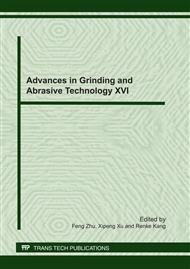p.149
p.155
p.160
p.164
p.169
p.175
p.180
p.184
p.189
Influence of Pore-Forming Agent on the Performance of Resin Bond Diamond Grinding Wheel in Back-Grinding Silicon Wafers
Abstract:
Back grinding is the key working procedure in the silicon wafer manufacturing process. Ground silicon wafers ought to have low subsurface damage layer thickness (SSD ) and surface roughness value. It requires that the wheel should have high self-sharpening ability and consistent performance. In this paper, the research on pore-forming agent in order to improve the wheel’s self-sharpening ability of the resin-bond diamond grinding was conducted. The research includes the pore-forming mechanism of various pore-forming agent, the influence of pore-forming agent’s type and the effect on the bond’s strength, the influence of pore-forming agent on the grinding performance of the wheel. Moreover, it examines the improved grinding wheel’s grinding effect by grinding tests.
Info:
Periodical:
Pages:
169-174
Citation:
Online since:
July 2011
Price:
Сopyright:
© 2011 Trans Tech Publications Ltd. All Rights Reserved
Share:
Citation:


